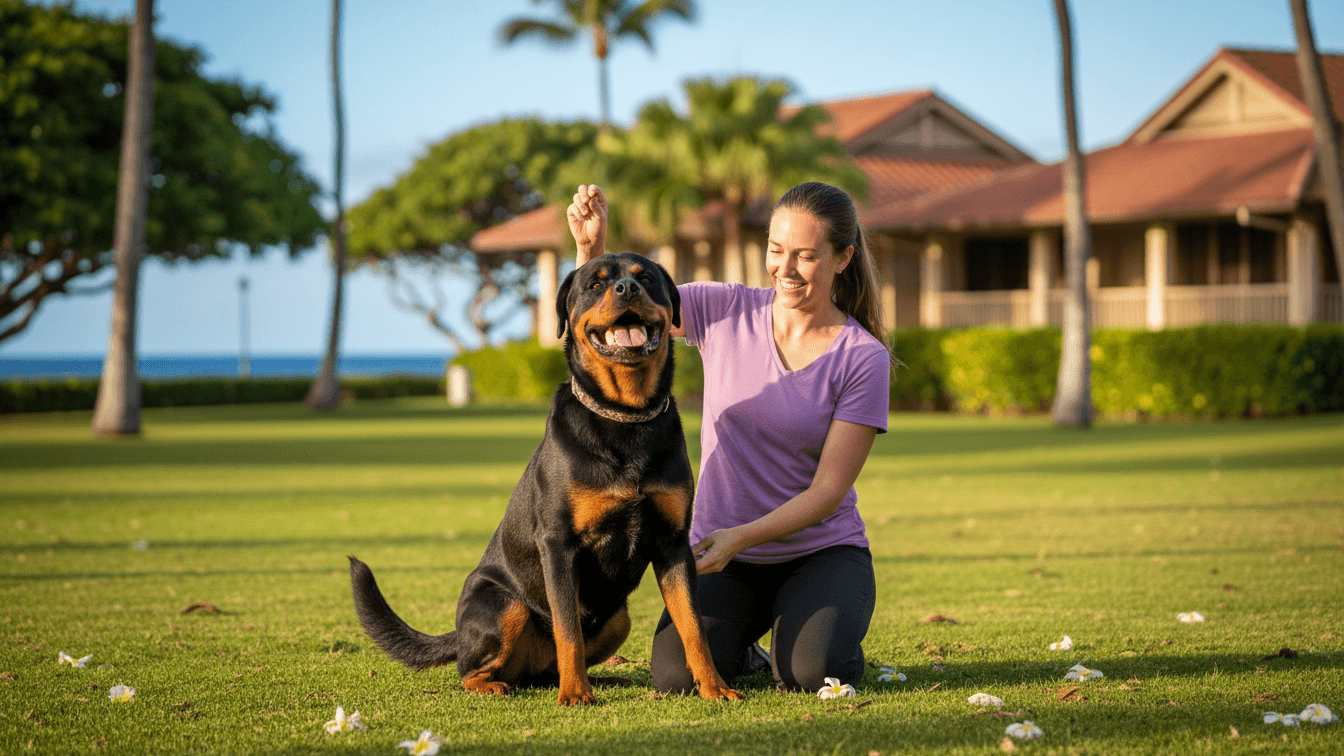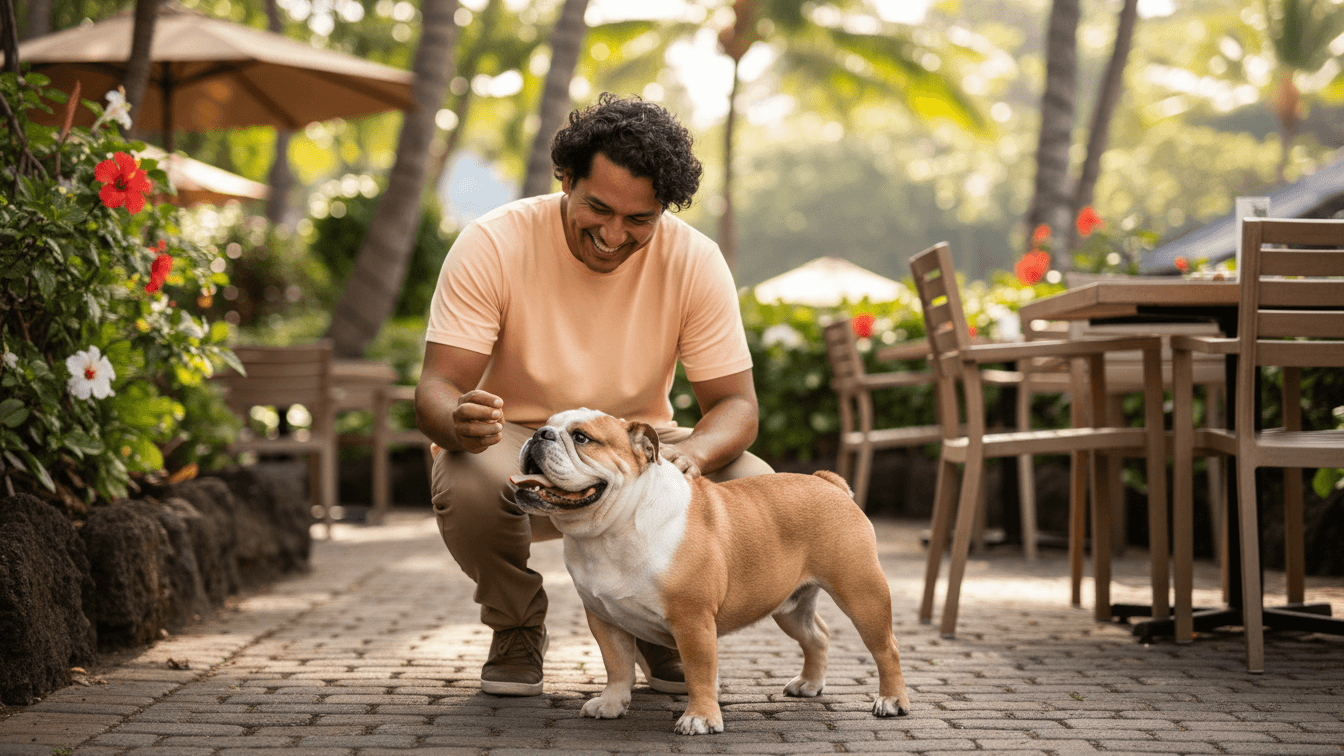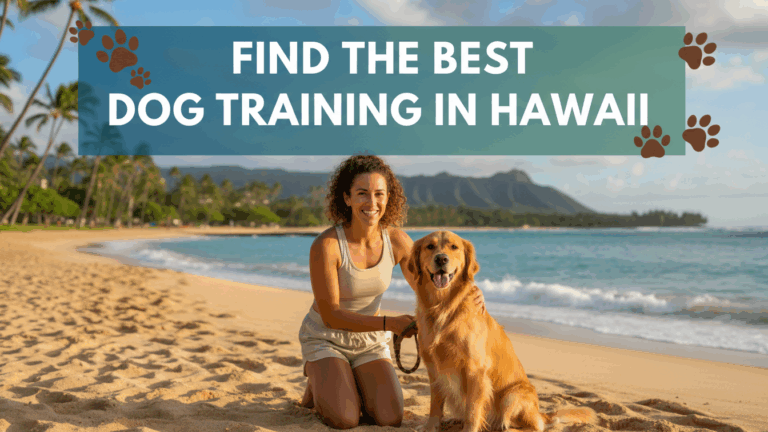Your Complete Guide to Choosing a Dog Trainer in Hawaii
Living with a dog in Hawaii brings unique rewards and challenges. From the beaches of Oahu to the trails of Maui, your dog needs to handle everything from busy tourist areas to wildlife encounters. Whether you’re navigating crowded spots in Honolulu or exploring quieter neighborhoods in Hilo, finding the right professional dog trainer makes all the difference.
Hawaii’s island environment creates specific training needs. Your dog might need to stay calm around unfamiliar tourists, ignore monk seals and sea turtles, or handle the sounds and smells of local wildlife. A trainer who understands these island-specific situations will help you build the skills your dog actually needs.
How to Choose the Right Trainer
Start by looking for someone who uses positive reinforcement training and understands Hawaii’s unique lifestyle. Your dog should learn to walk politely past beaches where people are picnicking, stay calm when encountering protected wildlife, and behave well in pet-friendly restaurants and shops.
Credentials give you a reliable way to compare experience levels. Common dog trainer certifications include KPA-CTP, CPDT-KA, or IAABC-CDBC for behavior problems. If your dog shows aggression or serious reactivity, look for someone with CBCC-KA or a structured program like CTC.
In-home dog training works great for puppies learning house manners, door greetings, and basic neighborhood skills. Group classes make sense once your dog can focus around other dogs, especially before you try busy public spaces. Private lessons let you customize everything around your specific goals, whether that’s preparing for beach visits or building confidence around tour groups.
Common Dog Training Methods Explained

Reward-based methods build trust while creating lasting behavior changes. They also help you follow Hawaii’s animal welfare rules and keep your dog safe around protected species.
Basic obedience covers sit, down, stay, place, recall, and leash training so your dog can handle beach walks, outdoor restaurants, and park visits without pulling or jumping on strangers. These skills become essential when you’re navigating crowded tourist areas or narrow hiking trails.
Puppy training focuses on socialization, potty training, bite control, crate comfort, and early leash skills. Starting young helps prevent problems later, especially important when you’re raising a dog in high-traffic tourist areas or near sensitive wildlife habitats.
Behavior modification addresses fear, reactivity, resource guarding, or separation anxiety through careful desensitization and counterconditioning. For serious cases, ask if your trainer coordinates with local veterinarians who understand island-specific stressors.
Dog training classes help your dog practice good manners around other dogs and people. The best classes maintain appropriate spacing, screen participants carefully, and teach calm behavior rather than just excitement.
Board and train programs immerse your dog in intensive training sessions while you’re away. Make sure the facility follows humane methods and includes thorough handoff sessions so you can maintain the progress at home.
Specialized training like service dog training or therapy dog training requires extra structure, public-access skills, and a clear step-by-step training program. Hawaii has specific requirements for service animals in public spaces, so work with a certified dog trainer who knows these rules.
Stay away from trainers who use fear, intimidation, or pain to get results. Humane methods are safer, easier to maintain long-term, and better for keeping your dog calm in Hawaii’s busy public spaces.
Average Cost of Dog Training in Hawaii (Updated for 2025)
Prices across Hawaii tend to run higher than mainland averages due to the islands’ cost of living and limited trainer availability. Here’s what most dog owners are paying in 2025.
| Service Type | Average Cost (Hawaii) |
|---|---|
| Puppy classes (4-6 weeks) | $200-$350 total |
| Group obedience classes (4-6 weeks) | $220-$400 total |
| Private lessons (60-90 min) | $140-$250 per session |
| In-home coaching packages (4-6 visits) | $550-$1,200 total |
| Day training (per week) | $600-$1,300 total |
| Behavior consult (initial) | $175-$300 |
| Board and train (2-4 weeks) | $2,500-$6,000 total |
You might pay extra travel fees if you’re on a neighbor island or in a remote area. Behavior modification for reactivity or aggression typically costs more than basic obedience training.
Make sure you understand what’s included in each package, how the trainer tracks progress, and whether they offer a free consultation or free evaluation before you commit.
Questions to Ask a Potential Dog Trainer
- What training methods do you use, and how do you keep training sessions positive and low-stress?
- What credentials do you have, like CPDT-KSA or KPA-CTP? Do you keep up with continuing education?
- How will you customize the training program for my dog’s specific needs and our Hawaii lifestyle?
- Do you offer in-home visits, dog obedience training classes, or day training, and which approach fits my goals best?
- How will we measure my dog’s progress and know when to add more challenging distractions?
- What are the total costs, including any travel fees between islands, and what’s your cancellation policy?
- Do you carry liability insurance, and can you show me proof?
- For behavior problems, will you work with my veterinarian if needed?
- What should I practice between sessions to help my dog keep improving?
- Are you familiar with Hawaii’s leash laws and rules about dogs near protected wildlife?
Local Hawaii Rules and Considerations
Hawaii enforces strict rules to protect both dogs and native wildlife. Understanding these regulations helps you avoid fines and keep everyone safe.
Leash laws vary by county but generally require dogs to be leashed in all public areas except designated off-leash dog parks. On Oahu, dogs must be on leashes no longer than 8 feet in most public spaces. Maui County and Hawaii County have similar restrictions.
All dogs in Hawaii must have current rabies vaccinations. The state follows a strict rabies quarantine program for incoming animals, which you can learn more about through the Hawaii Department of Agriculture Animal Quarantine Information Center.
Dogs are prohibited from approaching protected species like Hawaiian monk seals, sea turtles, and nesting seabirds. Violating these rules can result in hefty federal fines. Your trainer should help your dog learn to ignore wildlife from a safe distance.
Excessive barking can lead to nuisance complaints, especially in densely populated areas like Honolulu neighborhoods or condo complexes. Work on separation anxiety and alert barking before neighbors file complaints.
Hawaii doesn’t require special licenses for dog trainers. However, any business that boards dogs for payment must follow health and safety regulations through their county’s animal control division.
If your trainer wants to use county parks for dog training services, they may need permits and proof of liability insurance. Check with individual county parks departments for specific requirements.
Local Hawaii Resources for Dog Owners
These locations give you great places to practice obedience training, work on socialization, and help your dog become well-behaved in public settings. Always follow posted rules and respect other park users.
- Moanalua Dog Park in Honolulu offers a fenced area where you can practice off-leash recalls and calm greetings during quieter times of day.
- Hawaii Kai Dog Park on Oahu provides separate areas for small and large dogs, perfect for building confidence and working on dog-to-dog manners.
- Kaka’ako Waterfront Park allows leashed dogs and gives you opportunities to practice focus around joggers, skateboarders, and families.
Maui Humane Society and Hawaiian Humane Society both offer resources for dog owners including low-cost vaccination clinics and lost pet services. Many county animal control offices provide information about licensing requirements and local ordinances.

FAQs
How much does in-home dog training cost?
Most Hawaii trainers charge $140-$250 per in-home visit, with package discounts available when you commit to multiple sessions. Behavior problems and aggressive dog training typically start at the higher end of that range.
Is in-home dog training worth it?
Yes, because you’re addressing problems exactly where they happen. Your trainer can fix door manners, jumping on guests, counter-surfing, and yard reactivity right at home, then step outside to practice leash skills on your actual neighborhood streets.
Can you pay someone to house train your dog?
Absolutely. Many trainers offer puppy training programs that include potty training, crate routines, and daily schedules. Day training can speed up the process while teaching you how to maintain the progress independently.
What is the 3-3-3 rule for dog training?
This is a helpful timeline for new or adopted dogs: expect about 3 days for your dog to decompress, 3 weeks to learn your routines, and 3 months to feel completely settled. Good training for dogs works with this natural adjustment period rather than against it.
How long will it take to reach my training goals?
Most puppies and friendly adult dogs show solid progress within 4-8 weeks if you practice daily. Fear, reactivity, or aggression typically requires several months of careful behavior modification with gradual increases in difficulty. Hawaii’s busy public spaces can extend timelines because there are so many distractions to work through.
What should I bring to group classes?
Pack a flat collar or harness, a 6-foot leash, high-value treats, water, and current vaccination records if your trainer requests them. Leave retractable leashes at home for safety reasons. Bring extra water in Hawaii’s warm conditions.
What’s the leash law in Hawaii?
Dogs must be leashed in all public areas except designated off-leash dog parks. Leash length requirements vary by county, but most require leashes of 8 feet or less. Check your specific county ordinances for exact rules.
Do I need a dog license in Hawaii?
Yes, most Hawaii counties require annual dog licenses. On Oahu, register through the City and County of Honolulu Department of Customer Services. Maui County, Hawaii County, and Kauai County each have their own registration requirements and fees.
What shots does my dog need in Hawaii?
Rabies vaccination is required statewide. Your veterinarian may also recommend distemper-parvo, leptospirosis, and bordetella based on your dog’s lifestyle and exposure risks. Hawaii’s strict quarantine rules make current vaccinations especially important.
Are dog trainers required to be licensed in Hawaii?
No special trainer licenses exist in Hawaii. Expert dog trainers follow normal business regulations, but if they offer board and train services, their facility may need to meet county health and safety standards. Look for trainers who carry liability insurance.
Where can I practice off-leash recall?
Use fenced dog parks to keep things safe and legal. Moanalua Dog Park, Hawaii Kai Dog Park, and other designated areas let you work on recalls without risking your dog running toward wildlife or traffic.
Which dog parks allow training around Hawaii?
All county-operated dog parks allow training within their fenced boundaries. Check individual park rules, but most welcome respectful training as long as you’re not disrupting other dogs. Visit during off-peak hours when you’re starting out.
What beaches or trails allow dogs for training?
Beach access for dogs varies by county and specific location. Many Hawaii beaches prohibit dogs entirely to protect wildlife and maintain cleanliness. On Oahu, some areas of Kaka’ako Waterfront Park and certain designated beach sections allow leashed dogs. Diamond Head Trail and Makapuu Lighthouse Trail on Oahu permit leashed dogs, giving you excellent opportunities to practice focus around hikers and scenic distractions. Always check current rules before visiting any beach or trail.
What should I do if my dog encounters protected wildlife?
Keep your distance and immediately redirect your dog away from monk seals, sea turtles, and nesting birds. Federal law requires staying at least 50 feet away from monk seals and 10 feet from sea turtles. Your trainer should help your dog learn a strong recall and “leave it” command to prevent dangerous or illegal encounters.
Can my dog go to outdoor restaurants in Hawaii?
Many Hawaii restaurants welcome dogs on outdoor patios, but each business sets its own policy. Basic obedience skills like a solid down-stay and polite greetings make these visits easier. Practice in quiet locations first before trying busy tourist spots.
The right combination of thoughtful planning, humane methods, and consistent practice will help your dog become a confident, well-behaved companion throughout the Hawaiian islands. Whether you’re in urban Honolulu, residential areas in Hilo, or tourist spots in Lahaina, the best dog trainer for your situation will understand these unique island challenges and help your dog thrive.
